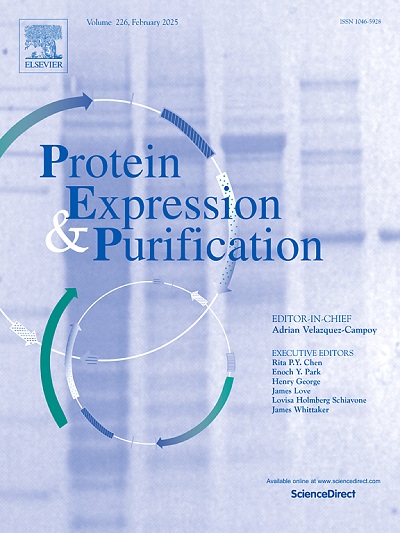The tumor suppressor LZTR1: Its expression, purification and characterization
IF 1.2
4区 生物学
Q4 BIOCHEMICAL RESEARCH METHODS
引用次数: 0
Abstract
Leucine-zipper transcription regulator 1 (LZTR1) serves as a tumor suppressor gene that is highly mutated and has been implicated in the pathogenesis of diverse cancers and developmental disorders. The LZTR1 protein is a member of the BTB-Kelch superfamily and functions as an adaptor that enables the recognition and recruitment of RAS proteins, which are then targeted for ubiquitination by the Cullin3-RING ligase E3 (CRL3) complex. Understanding the assembly mechanisms, substrate recognition patterns, and pathological processes associated with RAS ubiquitination mediated by LZTR1-CUL3 is critical. In this study, we report the expression, purification, and characterization of the LZTR1 to investigate its molecular mechanisms. Our findings demonstrate that the BacMam expression system significantly enhances LZTR1 production and simultaneously improves its stability and solubility. Furthermore, the existence of CRL3 contributes to stabilizing and homogenizing LZTR1 through facilitating the formation of the complex. Additionally, we identified MRAS as a substrate that binds tightly to LZTR1, in contrast to RIT1 and HRAS. Successfully expressing and purifying the full-length CRL3LZTR1-MRAS complex provide a foundation for future structural and functional investigations and offer a potential approach for exploring other BTB proteins with similar characteristics.
肿瘤抑制因子 LZTR1:其表达、纯化和表征
亮氨酸拉链转录调节因子1 (LZTR1)是一种高度突变的肿瘤抑制基因,与多种癌症和发育障碍的发病机制有关。LZTR1蛋白是BTB-Kelch超家族的成员,其功能是作为一个接头,使RAS蛋白能够被识别和招募,然后被Cullin3-RING连接酶E3 (CRL3)复合物泛素化。了解LZTR1-CUL3介导的RAS泛素化相关的组装机制、底物识别模式和病理过程至关重要。在本研究中,我们报道了LZTR1的表达、纯化和表征,以探讨其分子机制。我们的研究结果表明,BacMam表达系统显著提高了LZTR1的产量,同时提高了其稳定性和溶解度。此外,CRL3的存在有助于LZTR1的稳定和均质化,促进了配合物的形成。此外,我们发现与RIT1和HRAS相比,MRAS是与LZTR1紧密结合的底物。成功表达和纯化全长CRL3LZTR1-MRAS复合体为未来的结构和功能研究奠定了基础,并为探索其他具有相似特征的BTB蛋白提供了潜在的途径。
本文章由计算机程序翻译,如有差异,请以英文原文为准。
求助全文
约1分钟内获得全文
求助全文
来源期刊

Protein expression and purification
生物-生化研究方法
CiteScore
3.70
自引率
6.20%
发文量
120
审稿时长
32 days
期刊介绍:
Protein Expression and Purification is an international journal providing a forum for the dissemination of new information on protein expression, extraction, purification, characterization, and/or applications using conventional biochemical and/or modern molecular biological approaches and methods, which are of broad interest to the field. The journal does not typically publish repetitive examples of protein expression and purification involving standard, well-established, methods. However, exceptions might include studies on important and/or difficult to express and/or purify proteins and/or studies that include extensive protein characterization, which provide new, previously unpublished information.
 求助内容:
求助内容: 应助结果提醒方式:
应助结果提醒方式:


